Photo of the day: 0520050E4251650N 02132019 Taking Rock samples.jpg
Journalist Report – February 13th
Crew 205 Crew Journalist Report 13-FEB-2019 Sol 2
Author: Maria Grulich
Title: Water, Water, Everywhere
After our Spanish night yesterday, the girls decided to open the first water-efficient hair wash salon on Mars. It felt like on Earth we just had to skimp on the extra products 🙂
After this, the crew woke up refreshed and ready to tackle another day on Mars, including another 4 hour EVA. Dave, Hannah, Veronica, and Nathan left at 10:25 to go towards Candor Chasma. Exploring the cannon, they found beautiful rocks which seemed to be perfectly smooth, a sign of past liquid water. Dave and Nathan seemed to be bighorn sheep in their former life climbing up the Martian mountains.
The team achieved all its objectives and even had time to take some pictures.
The Hab team checked all EVA suits and replaced several batteries to make sure that all EVA suits are working properly before going out.
At 15:00 the second EVA had the plan to go up the mountain and take some samples and fly the drone to take pictures of the terrain. Unfortunately, the wind picked up and we decided not to take out the drone. Still, we planned to collect samples of stratified layers.
Once we stepped out and climbed the first hills the weather changed, and the team could only collect one sample out of the planed 4 of the stratified layers.
The team returned after 50 min. The fog inside the helmet made it very hard to climb down the mountain. Still, the day will be used to do an analysis of the samples, to prepare astronomy observation, maintain the Hab, water the GreenHab, and start the first videos about life on Mars. We also met yesterday’s goal of using only one loft tank of water.
One lesson learned is that data and water are currently our most precious resources and more measures to protect these resources have to be taken.
After the work is done and all reports are submitted the crew 205 will have a movie night.
Ad Astra!
Greenhab Report – February 13th
Crew 205 Green Hab Report – 13-FEB-2019
GreenHab Officer: Nathan Hadland
Environmental control: Heating and Cooling w/ ambient air (0 hrs)
Shade Cloth (40%)
Average temperatures:
Low: 17.4°C
High: 27.3°C
Hours of supplemental light: 5 Hours
Daily water usage for crops: 12 gallons
Water in Blue Tank: ~ 264.5 gallons
Time(s) of watering for crops:
TIME NOTED TEMPERATURE(° C ) / HUMIDITY(%)
[AT TIME OF WATERING]
1) 09.00 AM 21.4° C / 28 %
2) 12.00 PM 22.2° C / 24 %
3) 15:30 PM 21.9° C / 27 %
4) 18:15 PM 25.5° C / 33 %
Changes to crops: New seedlings sprouting around the large tomato plant in the grow bed.
Narrative: We continued regolith sample collection in Candor Chasma and will continue characterization throughout the evening using the dissection and optical microscopes. We are also performing spectral analysis using a spectrometer for preliminary elemental characterization.
The A. Thaliana has not germinated yet on the agar germination plates, so we are considering using a damp paper towel germination as a backup. The GreenHab dropped in temperature today due to persistent cloud cover. However, the heater mitigated the temperature fluctuations.
The red leaf lettuce us not showing any pigmentation, which is a possible indicator of plant stress. Additionally, the peas still have yellow pigmentation, which leads us to believe there are nutrient and nitrogen deficiency in those pots. We will continue to monitor these experiments.
We are still waiting for the arrival of seeds.
Harvest: None.
Support/supplies needed: None
Science Report – February 13th
Science Report 13 February 2019
Crew 205 – International Emerging Space Leaders
Submitted and prepared by GreenHab Officer Nathan Hadland
1.) ISRU Study: Geological characterization of regolith samples began with observations under the optical and dissection microscopes. We have also been performing spectral analysis using a spectrometer to get the initial elemental characterization. Analysis of pH and redox potential of samples to determine the suitability of the substrate to host plant growth will be investigated in the coming days. Additionally, the Arabidopsis thaliana seeds were prepped using a washing protocol and plated on an agar germination plate. We are waiting on germination to occur. Dead plant material from the GreenHab was taken and dried using an oven in the Science Dome and subsequently weighed for the cellulosic ethanol ISRU study.
2.) GreenHab: Dead and live samples of cucumbers were taken from the GreenHab and wet mounts were prepared and viewed under the optical microscope. We found evidence of degraded cell structure, likely from the fungi growing on the dead plants. The live tissue comparatively had all of the expected components of plant cells including stoma and clear cell walls. The carrots that were not harvested were moved from around the grow bed and consolidated into one section of the planter.
3.) Astronomy: The variable star SY MON was observed on 11 Feb 2019. The observation session was one 60 s exposure using the V filter. On 12 Feb 2019, the magnitude value was measured for SY MON using AstroImage J software. The magnitude value was found to be 14.147. The value will be submitted to the AAVSO. Another observation session was submitted on 12 Feb 2019. The session was for the ASASSN-V J081823.00-111138.9 variable star with the aim of drawing a light curve. The observation session was 9 exposures in the V filter and 9 exposures in the B filter. The V filter exposures were 60 seconds, and the B filters exposures were 120 seconds. However, due to the bad weather, no images were captured.
4.) EVA Project: The primary research technique was changed after testing analysis methods from the mission plan during EVA’s of the first 2 days. A new research focus has been adopted and is currently under development. In practice, a “score” will be assigned to each EVA to determine its effectiveness by evaluating various parameters. More data will be available in upcoming reports.
5.) Effective Leadership: Role rotations will begin tomorrow and the first survey conducted on the current commander, N. Larrea will be collected tonight.
6.) Developing Guidelines (SOPs): Water conservation procedures, improved communications procedures, and EVA preparation procedures are being developed. An inventory of the Science Dome, GreenHab, and the RAM are also being compiled as well as an improved list of food provided to crews.
Astronomy Report – February 13th
Crew 205 Astronomy Report 13 Feb 2019
Crew Astronomer: Ghanim Alotaibi
MDRS ROBOTIC OBSERVATORY
Robotic Telescope Requested: MDRS-14
Objects Viewed: Out of the 18 images requested last night, I found only 12 images were captured. However, all the captured images were found to be bad for photometry. The seeing condition was not good yesterday for astrophotography and it was decided to resubmit the observation session.
Problems Encountered: Bad weather conditions.
EVA Report – February 13th
Crew 205 EVA Report 13 FEB 2019
EVA #06
Author: D. Masaitis, Executive Officer
Purpose of EVA: Terrain familiarization and sample collection
Start time: 1500
End time: 1551
Narrative: Meteorological conditions altered the EVA plan immediately, with high winds making flight testing of Crew 205’s unmanned aerial vehicle non-viable. The UAV was therefore left at the Hab prior to departure, but sample collection materials were retained. EVA #06 began at 1500 hours. The team headed to Old Repeater Point to proceed with geological sample collection and photography.
Halfway through, it started to rain. Increasing rain intensity made terrain slippery and the helmets in the EVA suits foggy. These conditions made operations difficult, and after evaluating their situation, the team decided to return to the Hab. EVA was concluded earlier than planned at 1551 hours.
Destination: Old Repeater Point, North Ridge
Coordinates: 4250900/517950 (Old Repeater Point), 4251500/518600 (North Ridge)
Participants: Natalia Larrea (CO), Daniel Robson (HSO), Maria Grulich (MEDIA) Ghanim Alotaibi (ASTRO)
Roads and routes per MDRS Map: Climbing western ridgeline to Old Repeater Point, then proceeding north and then northeast to North Ridge
Mode of Travel: Walking
EVA Report – February 13th
Crew 205 EVA Report 13 FEB 2019
EVA #05
Author: D. Masaitis, Executive Officer
Purpose of EVA: Terrain familiarization and sample collection
Start time: 1030
End time: 1320
Narrative: Crew 205 received a mission change at 0800 hrs from the MDRS Director, and accepted a destination change from Maxwell Montes to Candor Chasma for their morning EVA. The team began pre-EVA preparations at 0930 hrs and entered the airlock for depressurization at 1020 hrs. The team initiated movement north on Cow Dung Road, using Curiosity and Opportunity to navigate north on Cow Dung Road and then east on Galileo Road. Communications were lost as expected, so the team proceeded east on Galileo Road before assuming a short halt at 0519900/4252950 to perform an orientation map check before descending into less-elevated terrain of S. Cactus Road.
Curiosity and Opportunity tracked southbound on Cactus Road (1104) until connecting with a dried stream bed, identified on the map as Stream Bed Connector. Here the team parked and dismounted to move into the western side of Candor Chasma.
Sample collection began as soon as the team got down into the canyon. V. Trivino (ENG) assisted N. Hadland with sample collection and labeling, while H. Blackburn took photographs of sample locations. D. Masaitis (XO) maneuvered slightly ahead of the collection team to locate follow-on collection sites, and the team continued to work its way east. By the time they reached 0520378/4251094 the team decided that they had collected enough samples as they could carry, and opted to return to the rovers. Upon reaching the rovers, there was still time remaining in the approved EVA window, so the team opted to backtrack up S. Cactus Road to get closer to a unique hilltop in the vicinity of 0520050/4251650.
After relocating the rovers, the team dismounted and climbed the hilltop to take some extra photographs for the Crew Journalist. While there, the EVA team established visual contact of N. Cactus Road heading towards Maxwell Montes and confirmed it against the map. The team returned to the rovers and began moving back towards the HAB, making one additional short halt in the vicinity of 0519900/4252950 to take a few more photos while D. Masaitis (XO) re-established communications with the HAB.
After a successful communication with HAB Control, the EVA team backtracked its route to the HAB, stowed the rovers and reported rover SOC (Curiosity:71%, Opportunity:67%) and hours (Curiosity:74.3, Opportunity:50.1) to HAB Control. At 1320 hours, the EVA team initiated their 5-minute pressurization, ending the EVA.
Destination: Candor Chasma, western end
Coordinates: 0520300/4251100
Participants: Dave Masaitis (XO), Nathan Hadland (GHO), Veronica Trivino (ENG), Hannah Blackburn (COMMS)
Roads and routes per MDRS Map: Cow Dung Road (0110) to Galileo Road (1104) to South Cactus Road (1104)
Mode of Travel: Driving (Cow Dung Rd, Galileo Rd, S. Cactus Rd.) and Walking (W. Candor Chasma)
Sol Summary – February 13th
Sol: 3
Summary Title: The sound of Martian winds
Author’s name: Natalia Larrea
Mission Status: Nominal
Sol Activity Summary: We woke up with the smell of home-made brownies and coffee. The first EVA left at 10.00 am driving Curiosity and Opportunity rovers heading to Candor Chasma. The team collected excellent geological samples and had the chance to explore the area. Meanwhile, at the Hab, the team worked on new maintenance tasks. We checked the status of the EVA suits making sure they are fully operational. Batteries were replaced in those suits not working properly, making them now ready to be used. At the return of the EVA team, all the crew enjoyed together some Martian pasta with dried tomato and chicken sauce. In the afternoon, the second EVA team headed to explore the area surrounding the Hab.
The plan was to test Crew 205’s drone, collect samples and conduct photography. However, the Martian weather complicated the task. Winds were too strong to fly the drone. The team continued nonetheless, with its plans of climbing the Old Repeater Point. The view of MDRS was great from there! However, in the field, the rain started to hit and the space helmets started to become foggy. Walking on the hilly surface in such conditions was not easy. The team then decided to head back to the Hab, enjoy a warm coffee and tea, and continue working there. Tonight we plan movie night … maybe “The Martian”?;))
Look Ahead Plan: Most of the day tomorrow will be dedicated to working “from home” on the different projects. After a few days on Mars, we have started collecting many pieces of great science and data which need to be analyzed. A team will also head the Old Repeater Point and North Ridge for a short test the drone (if the weather permits), continuing with the initial plan of today.
Tomorrow is also Saint Valentine’s day so we plan a special evening and dinner with “Secret Valentine” presents included. In addition, it will be the first day we start rotating roles in the crew. The members in the position of commander and XO will be rotating for the next week.
Anomalies in work: None
Weather: Cloudy all day long, windy with light rain in the afternoon
Crew Physical Status: Nominal
EVA:
EVA#05: 0520300/4241100 (Candor Chasma)
EVA#06: 4250900/517950 (Old Repeater Point), 4251500/518600 (North Ridge, not reached)
Reports to be filed: Sol Summary, EVA report, EVA request, Operations Report, HSO Report, Astronomy Report, Science Report, Greenhab Report, Journalist Report
Support Requested: None


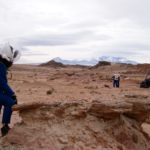
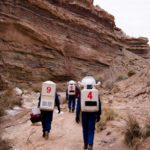
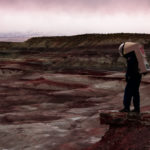
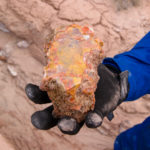
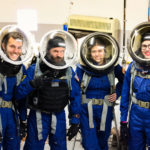
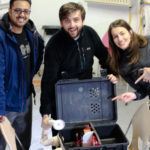
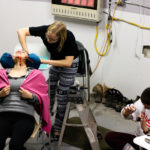
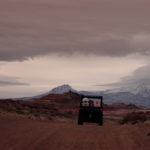
You must be logged in to post a comment.